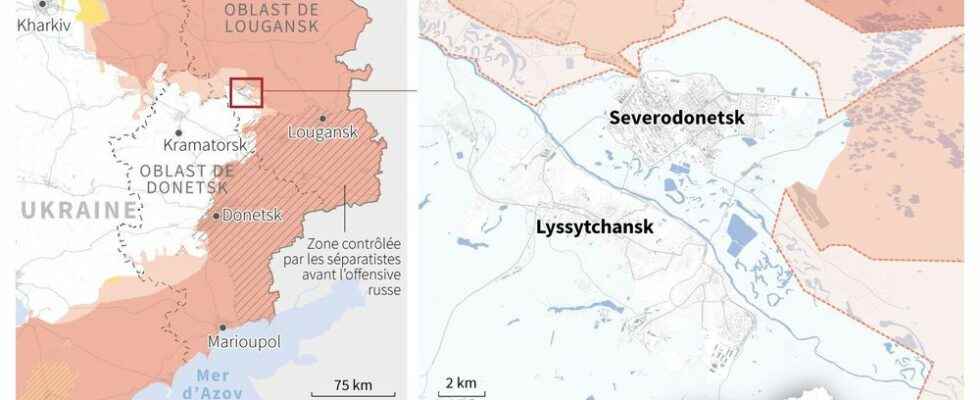L’Express: How fast are the Russians progressing in the Donbass?
Michael Goya: They are currently fighting two separate battles. First, they’re surrounding Lyman. This city, located at the outposts of Slovyansk, could be taken quickly by the Russians. Their efforts are also concentrated on Severodonetsk and a nearby town, Lyssytchansk. The new element is that they managed to seize Popasna, 40 kilometers south of Lyssytchansk. Located high up, this site will allow them to adjust their artillery fire.
They have also assembled a dozen battle groups in this region – concentrating their best elements there (assault troops, marine infantry, mercenaries from the private Wagner group, Chechen units) and they are trying to advance in all directions. As a result, they move relatively fast – about several kilometers a day. This allows them to go up to Severodonetsk and Lyssytchansk. The great danger is that they cut the road that feeds these two cities, because that would mean the encirclement of Severodonetsk, an industrial agglomeration which had 200,000 inhabitants before the war. If the Russians besiege the city, here we go again for a new Mariupol…
Map of Eastern Ukraine
PAZ PIZARRO, CLEA PÉCULIER, KENAN AUGEARD / AFP
And the second battle?
It targets Slovyansk and Kramotorsk. If the Russians capture Severodonetsk within the next two months and then succeed in conquering Slovyansk and Kramotorsk, they will have achieved their strategic objective. But this new sequence will have a high cost. Conquering the rest of Donbass will cost them 10,000 men.
Opposite, what about the Ukrainian resistance?
Can the Ukrainians oppose all this? They have already committed a reserve brigade, they will certainly have to throw others into the battle. Will they attack elsewhere, for example in Kharkiv, to relieve the main front? In any case, they are faced with the same question as the Russians: how to continue the fight for two or three months at such a level of violence and destruction? Volodymyr Zelensky admitted that his army was losing 50-100 men every day in the Donbass. On the Russian side, it’s about the same – and maybe even more.
What is the balance of power in the East?
It can be estimated that there are 40,000 to 50,000 Russian and pro-Russian soldiers engaged in this battle of Donbass, against 30,000 Ukrainians. The Russians deploy 600 tanks there, against 300 opposite. The ratio is also 1 to 2 for artillery, which remains the strong point of the Russian army. On the other hand, it loses almost as many armored vehicles in the Donbass as during the battle of kyiv! In fact, they may soon start running out. Recently, they come out of the old T-62 tanks, dating from the sixties, which suggests that they are beginning to have serious supply difficulties.
Can the delivery of American and French guns (Caesar) make the difference?
These weapons are very effective, but there are not enough of them to change the tide of battle. There are only a few dozen, while opposite, the Russians line up several hundred artillery pieces.
If he manages to conquer the Donbass, can Putin stop there?
War is like economics, you have to think in terms of marginal cost: is it worth continuing? If we consider that the sacrifices are useless, we stop. But for now, both sides consider it worth continuing… If the Russians seize Donbass, they can decide that they have achieved their strategic objectives, “lock down” the area and negotiate a ceasefire -fire. For their part, the Ukrainians may want to negotiate peace – even if it risks being temporary… In fact, everything will depend on their resources. They can mobilize many men, but they still have to be trained. It takes months of practice. As for their stocks, they are quite large, but not unlimited, like Western aid, which risks reaching its limits in a few months.
If a ceasefire agreement is finally signed, how will Ukraine be able to live with this dangerous neighbour?
Unless there is a real change of regime, on the Russian side, accompanied by a real peace agreement, Ukraine is condemned to live in a state of permanent mobilization. Such an organization began to be put in place, before the war, with the territorial forces and the volunteer units – but it was unfortunately not taken far enough. If there had been 700,000 well-trained reservists available in the early days of the conflict, things would have been even more difficult for the Russians… As long as there is this threat, Ukraine will be forced to remain a nation in weapons, like Israel with some Arab countries…
